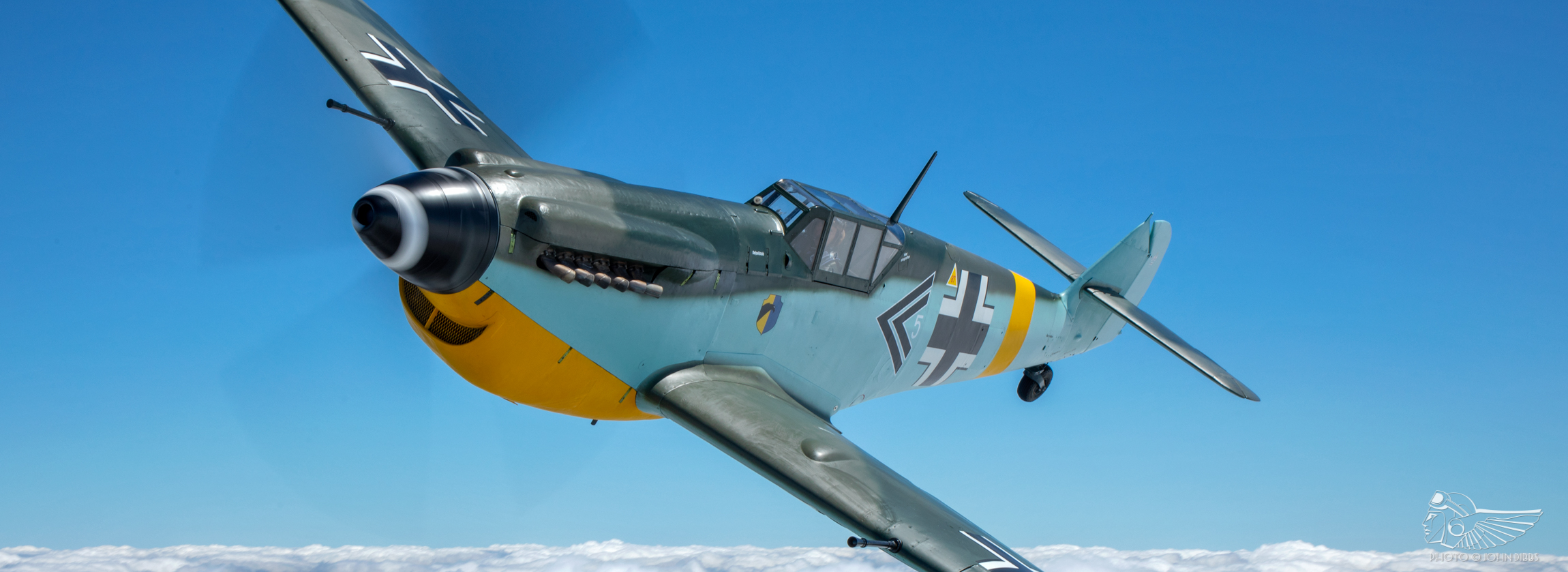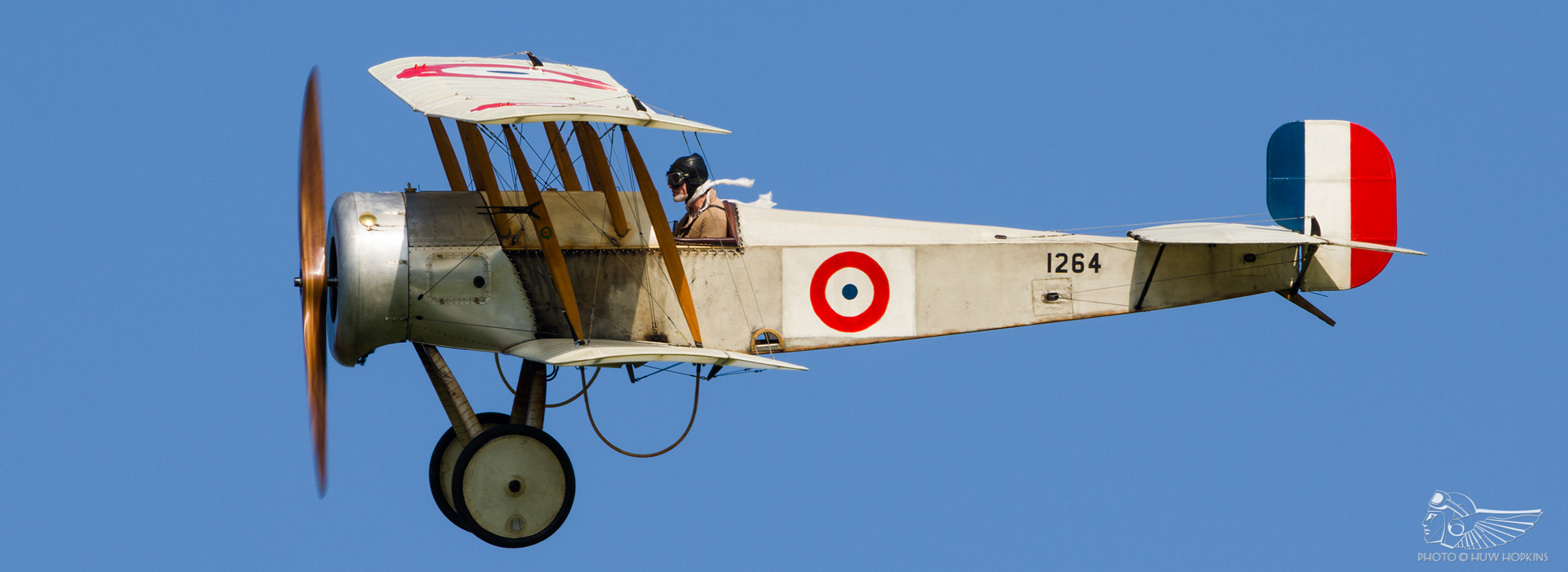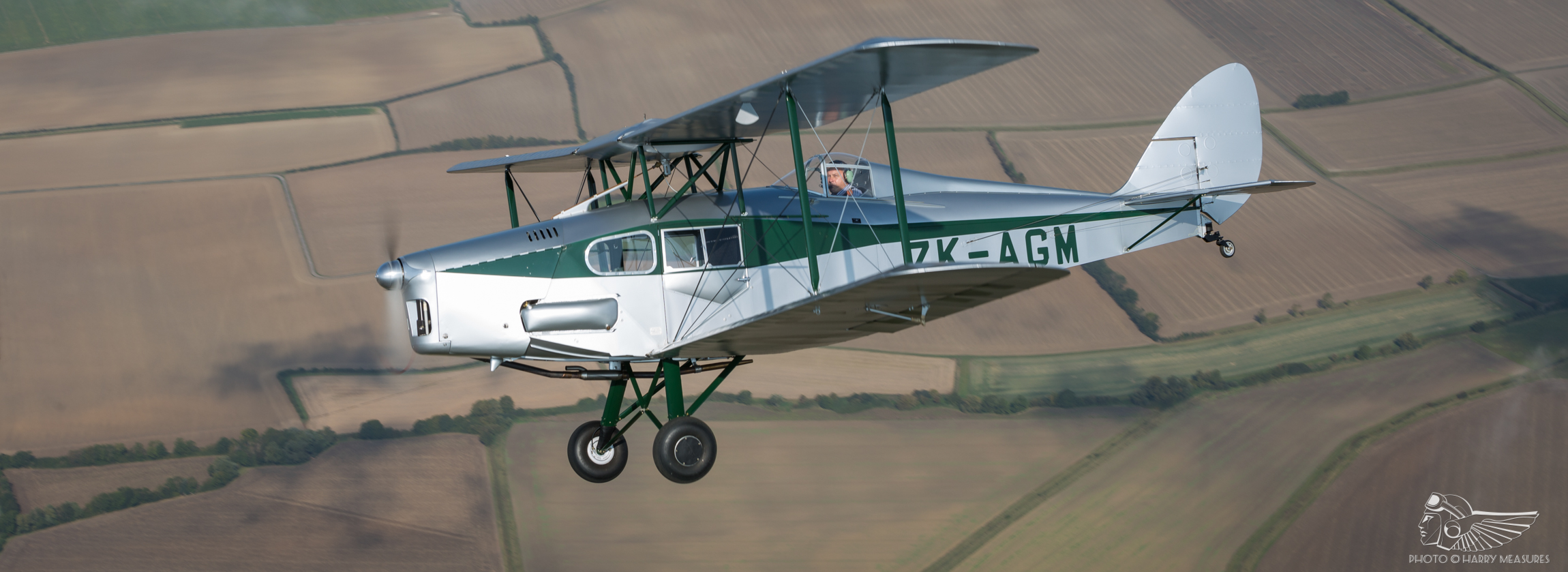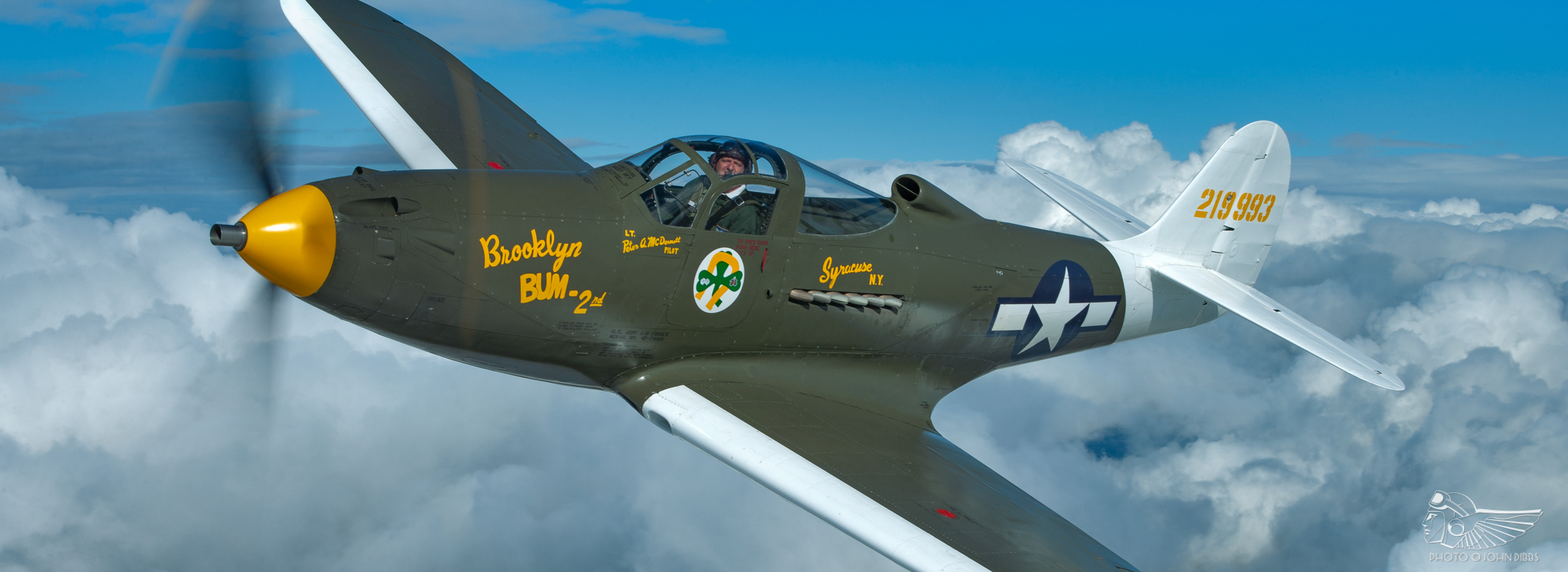The Spanish-built, Rolls-Royce Merlin-engined Hispano Aviación HA-1112 Buchón is not merely a ersatz Messerschmitt Bf 109. To describe it as such is a fallacy that undermines the aeroplane’s rich military history and diminishes the significant role it has played in recalling the past as the perennial silver screen and airshow ‘bad guy’.
Richard Grace concurs. “I’ve always had a bit of a thing for them. In the house I grew up in we had a photo on the wall of my father looking back over his shoulder in his Buchón [G-BOML] after his first flight, which he elected to do with only a windscreen – no canopy – because the canopy was so bloody heavy! He thought, if I’ve got to hop out of this, I don’t want the canopy in the way. Good on him – he’s a braver man than I!”
As Managing Director and Chief Engineer of Sywell-based Air Leasing, Richard has presided over the restoration of four ex-Ejército del Aire (EdA; Spanish Air Force) and Battle of Britain film star Buchóns and has amassed significant hours on the type since the first of these flew again in autumn 2017.
“There is an appropriate level of mystique to it”, he says, “and its reputation precedes it. Dave Southwood came up to me at Duxford before we got the first Buchón flying. He’d flown the Charles Church one after only about 25 Spitfire hours. He said that it’s not the aeroplane you want to fly too soon – there’s certainly a lot of truth in that – and that he thought he’d flown it too soon. You don’t want it to be the first warbird you fly – you don’t want to be learning to fly a V12 whilst trying to get to grips with the Buchón.”
The Buchón’s complex development history, air force career and post-retirement civilian exploits could fill several weighty tomes, and the contextual overview presented here is a mere précis of the type’s fascinating origins.
Hispano spent years seeking a suitable power plant for its licence-built Messerschmitt Bf 109s – fundamentally Bf 109G-2 airframes designated the HA-1109-J – having trialled Hispano-Suiza’s 12Z-89 and 127-17 engines with poor results, and it wasn’t until the Spanish arms embargo was lifted in 1952 that a suitable alternative to the Bf 109G model’s original Daimler-Benz DB605 became available. These Merlin 500/45 engines were ordered in large numbers for use in the HA-1109 and CASA 2.111 (the Spanish licence-built version of the Heinkel He 111), and on 29 December 1954 the HA-1109 flew for the first time with a Merlin. Further development led to the establishment of the HA-1112-M1L fighter and ground attack variant that adopted the name ‘Buchón’ (so named after a deep-breasted pigeon from Seville), fitted out with Hispano HS-404 20mm cannons and eight 80mm underwing Oerlikon rockets.
172 Buchóns were built by Hispano Aviación, an unknown number of which were initially mated with Hispano-Suiza engines before conversion to the Merlin 500/45. The first 60 aircraft were delivered to the EdA on 31 December 1956, and the formative Buchón unit, 71 Escuadrón, became operational at Tablada on 15 February 1957. The type remained in service for a little over seven years, the EdA’s modernisation rendering it obsolete by the mid-1960s. The final squadron retired on 6 October 1965.
EdA Buchóns saw combat during the October 1957 to April 1958 conflict between Spain and the Moroccan Liberation Army – more than a decade after its predecessor flew its last combat mission over Germany. Operating from rough airstrips in the harsh Western Sahara Desert, the Buchóns flew in support of CASA 2.111 bombers and CASA 352 and C-47 troop carriers and provided top cover to the ground forces, notably during troop landings on the beaches of El Aaiún. Morocco and Spain signed the Treaty of Angra de Cintra on 1 April 1958, and the Buchóns were withdrawn to provide air policing – a role the aircraft carried out for several years until the last of the type were retired and stored at Tablada.
Meantime, Spitfire Productions were assembling aircraft for Guy Hamilton’s Battle of Britain movie production. Group Captain Thomas Gilbert ‘Hamish’ Mahaddie, charged with sourcing viable RAF and Luftwaffe aircraft for the film, acquired a large number of ex-EdA Buchóns at a public sealed-bid disposal auction in March 1966, paying a unit cost of around £800 per aircraft. In all, 28 Buchóns were available for the film, four of them aeroplanes owned by the Confederate Air Force and leased to Spitfire Productions for the shoot. 18 of the 28 were candidates for overhaul to flying condition, six were fit for ground-running and taxying, and the rest would make up numbers on the ground.
The Buchóns underwent significant physical modifications to disguise them as 1940-era Messerschmitt Bf 109Es, including the removal of their rounded wingtips, cannons and rocket rails, and the fitment of radio masts, tailplane struts, and mock-up machine guns in the wings and in the upper engine cowlings. Each aircraft received a Luftwaffe paint job representing one of three fictitious Jagdgeschwaders, denoted by red, yellow or white spinners and numerals. Aerial filming in Spain started on 13 March 1968, with the Buchóns operating from Tablada and El Copero. Shooting later relocated to the UK and 16 Buchóns (alongside two CASA 2.111s) decamped to Duxford, arriving on 14 May 1968 after a five-day journey from Spain. By the time the filming concluded in late September, the Buchóns had reportedly accumulated 2,700 flying hours and made 3,300 landings.
The late Wilson Connell ‘Connie’ Edwards was one of five Confederate Air Force pilots who flew in the Battle of Britain. When production wrapped, a fleet of 21 Buchóns (along with Spitfire Mk IX MH415) were gifted to Edwards as part-payment for his work on the film and shipped to his ranch at Big Spring, Texas, the following year. Most went into long-term storage and others were sold or traded, but Connie kept one – C.4K-152 – flying until the early 1980s. Though some left the ranch in the intervening period, the majority lay dormant in containers and hangars at Big Spring. The death of Connie’s son ‘Tex’ – an accomplished pilot in his own right – in a car accident in 2013 precipitated the sale of the collection. In late 2014, the eight remaining Buchóns and Spitfire MH415 were put on the market by Platinum Fighter Sales and then acquired by Boschung Global. Warbird Investments, an Australian consortium, subsequently bought two of them (Red 11 and Yellow 7) and asked Richard Grace to fly out to Big Spring to survey the aircraft.
He spent the long flight to Texas reading the manuals his father had acquired during G-BOML’s rebuild in the 1980s; he’s too young to remember that aircraft’s restoration, but the Grace family kept the original paperwork. Once there, he looked over the aircraft and drew up a figure for their restoration – Warbird Investments were satisfied, and contracted Air Leasing to restore the largely untouched aeroplanes in the UK. A third Buchón was acquired by Graham Peacock and eventually shipped to Sywell alongside the other aeroplanes owned by Boschung Global and Warbird Investments.
To date, four have flown – three single-seaters and a two-seater – and two further airframes are waiting in the wings for private owners. The first to fly did so after just 18 months in Air Leasing’s workshop. “Those aeroplanes were in remarkable condition when they arrived at Sywell”, says Richard, “primarily since west Texas isn’t a bad place to store things and the last people to maintain them in any way were the Spanish military, except for Connie’s own aeroplane, which was the last one we did [G-AWHR, White 5]. We went through them with a fine-tooth comb, but we didn’t particularly have to touch any of the basic structure on the first three. We stripped that back to bare metal, inspected it and found it to be okay – we were quite lucky that we didn’t have to reinvent the wheel to get them going again.”
First in line was Warbird Investments’ two-seat HA-1112-M4L, C.4K-112 Red 11 (G-AWHC), wearing the red spinner and numerals of Maj Föhn’s fictitious 2./JG 418. The affectionately named ‘Twochón’ was originally powered by a Hispano-Suiza engine as the HA-1110-K1L and served with Ala 7 and 471 Escuadrón. It flew as a camera-ship on the Battle of Britain film shoot and was later utilised as a training aircraft on which RAF pilots underwent their Buchón conversion following the EdA pilots’ return to Spain in late August 1968. Earlier in the month, it had flown to Montpellier, France with an entourage of two other Buchóns, nine Spitfires (among them several familiar serials – P7350, AR213, AB910, MH434, MH415, TE308, PM631 and PS853) and the B-25 cameraship in search of better weather for aerial filming.
“We tore it into a million pieces, stripped all the paint off inside and out – no mean feat! – took a seriously good look at everything in it, painted the basic structure back up and started overhauling each component that we’d removed”, continues Richard. Air Leasing found the aircraft to be in excellent condition, and he describes the process of returning each aircraft to flight as more akin to an extensive overhaul rather than a restoration.
“The Buchón is a very simple aeroplane. That may be why the Spanish opted to utilise it. It has simple systems and relatively few of them, and that made working on them far more straightforward than restoring something like a Spitfire. They all have less than 200 hours on them since they left the factory. When they arrived at Sywell they were likely in the same basic condition they’d been in when they were retired by the Spanish Air Force – and if we think we know better than the Hispano factory, we’re probably barking up the wrong tree!
“We tooled up to do multiple aircraft. When Red 11 entered the workshop, we knew we had another three or four to overhaul, so we ordered hoses for four aeroplanes. Likewise, the wood for the interior. Where possible, we ordered components in a ‘oner’ and had it all on the shelf.” Each aircraft received new hose assemblies and tyres, and fully overhauled undercarriage legs, propellers, hydraulic and fuel systems, and instruments. The Merlin 500/45 engines were removed in Texas and sent straight to Jose Flores’ workshop at Vintage V12s for overhaul.
“All of the aileron system is pushrod controlled, as are the flaps, and while we overhauled those parts we tried not to mess with the set-up because we knew that the Spanish did a really good job of rigging them. We plumbed the aircraft up, put new wires in and it seemed to work! It’s quite something that the vast majority of what’s in them – and I truly mean that – is original, restored to the condition it was in when it left the factory in the 1950s. All of them truly are time capsules.
“The fundamental difference between Red 11 and the single-seaters is that the two-seater’s rear seat messes with the fuel system. In the single-seaters the fuel is held in a 410-litre welded aluminium tank which is fitted through the bottom of the aeroplane and mounted around the pilot’s seat, with most of the tank behind the pilot and around a third of the fuel under the seat. In the two-seater, the fuel behind the pilot’s back was displaced by the extended cockpit section. Instead it has a slab belly tank, two smaller tanks behind the rear seat and two wing tanks, all of which are used. Helpfully, no schematic exists for the two-seater’s fuel system – I drew it out myself.
“We had to manufacture a pressure fuelling system to move the fuel from the fuselage to the wing tanks, as the aircraft fuels from one point and you can’t fuel the wing tanks directly. You only lose ten litres of fuel in that tank arrangement, which is impressive. The Buchón has a vast centre of gravity range and having another body in the back, and fuel displaced around the aircraft, doesn’t make any difference to performance.”
The original bulbous two-part blown canopy fitted to the aeroplane in Spain was substituted for a bespoke Messerschmitt Bf 109G-style canopy during the restoration. “I took one look at the original and decided it wasn’t fit for purpose”, says Richard. “The way it was attached to the aeroplane was beyond alarming; it was fine when it was completely shut, but if it cracked open in flight it probably would have been torn off. It couldn’t be jettisoned by the pilot in-flight and offered inadequate protection for pilot and passenger if the aircraft ended up on its back.
“The ‘Twochón’ is a passenger-carrying aeroplane and I wouldn’t feel comfortable putting passengers underneath the original canopy.” Seeking an alternative canopy profile in keeping with the aircraft’s pedigree, Richard worked with Merlin Engineers’ Chris Baglin to design a more suitable arrangement akin to the canopy of the G-series Bf 109s. “They built the canopy to my specifications and did a marvellous job. It’s sympathetic to the design, and safe for passenger operations. I consider what we’ve done to be a happy medium.” Purists should note that the original canopy – overhauled, serviceable and ready to fit – is stored at Sywell and could be mated to Red 11 should a future owner decide to revert the aircraft to its original specifications.
Preparing for the first flight in the Buchón was, Richard remembers, “A case of reading as much as possible, talking to as many people who’ve flown them as possible, and then making a judgement of how to approach it based on those impressions.
“It’s amusing – no one will bother spending hours telling you how to fly a Spitfire or Mustang because they fly normally, by warbird standards”, he notes wryly. “It sums up the Buchón rather nicely that there seem to be a hundred different ways to fly the aircraft and people will stress that you must fly the aircraft in the specific way they describe, or you will certainly crash! Whether my approach is right or wrong remains to be seen. There’s probably a right way in there somewhere, but no one is one hundred percent on what it is. A lot of people have had the aeroplane demonstrate something to them that colours their impressions.
“As a first post-restoration flight and a first flight on a new type, it wasn’t bad – I survived!” he jokes. When Red 11 lifted off from Sywell on 24 November 2017, it marked the first time the aeroplane had flown since October 1968. “The crucial factor with the two-seater is that it has a late model Bf 109 fin and rudder, with a servo tab on the rudder which it could do with not having – it makes the rudder too light, and that sensitivity means it wavers around in yaw. During my first take-off I swung around more than you’d expect because it’s just so sensitive to even minor rudder pedal pressure.
“The view in-flight is better than you imagine it’ll be. Once you embrace the fact you have terrible forward visibility at all times and can’t see the aircraft’s nose, it’s fine. Performance-wise, it climbs phenomenally and screams uphill at optimum power. It has brilliant, light ailerons. It is heavy in pitch at all speeds – two-hands-on-the-stick heavy – and that gets heavier as airspeed increases. From a handling perspective, that really stood out during the first few flights.
“Subsequently I’ve learned that having the trim set before you start – i.e. knowing where you need to set the trim to do a good job – is key, and you only learn that by setting the trim in the wrong position a couple of times. By comparison, the Mustang is very heavy in pitch too, but in the Mustang, you can still wind the trim up at high speed because you’re trimming a tab. In the Buchón, you’re trimming the whole tailplane and the trimmer goes just as stiff as the pitch, so it’s a mission to trim when the aeroplane is at high speed. There’s a placard in the cockpit that says, ‘No steep nose-down attitude below 500ft AGL’ because you potentially won’t be able to pull the aeroplane out of it. It’s interesting that it’s the same problem the Luftwaffe had with the E model – they never sorted it.”
Richard was also the first person to fly as a passenger in Red 11’s rear seat. “The view from the back is phenomenal. Other than the fact that you can see straight down because the rear seat is aft of the trailing edge of the wing, I found watching the auto slats utterly hypnotic.” These aerodynamically actuated leading-edge slats are a prominent feature of the Bf 109 series, designed to deploy automatically as the aircraft’s airspeed diminishes to improve slow-speed handling and delay the onset of the stall. “It’s something you can’t really see from the front as you’re busy flying it and you wouldn’t particularly know exactly when they’d come out. Watching the slats while Jonesy [Steve Jones] was doing aerobatics gave me an appreciation for what the wing’s doing during those manoeuvres.”
Single-seater C.4K-99 Yellow 7 (G-AWHM), a 1958-built aircraft that served with Ala 7 until November 1965, was next in line. Restored into its Battle of Britain film scheme with the yellow propeller spinner and numerals of Maj Falke’s fictitious 6./JG 418, Yellow 7 flew again on 3 May 2018. It has since departed Sywell and is now based with a private operator in Germany. Notably, it’s the only one of the four Air Leasing-restored Buchóns that flies with a three-blade propeller. “I’ve seen a lot of comments about the four-blader offering improved climb performance”, says Richard. “I hate to disappoint people, but there’s no difference in performance between the three and four-blade propellers whatsoever. You can only tell the difference in-flight because the four-bladed propeller balances better than a three-blade propeller, and three-bladers feel inherently rougher than four-bladed propellers.”
Then it was the turn of Ala 7 and 471 Escuadrón veteran C.4K-105 White 9, registered G-AWHM to Graham Peacock’s Anglia Aircraft Restorations stable and adorned with the black and white spinner, yellow cowlings and mottled grey Eastern Front camouflage of a Bf 109F-4 flown by III./JG 52 ace Unteroffizier Edmund Roßmann. To this author, ‘White 9’ has the look of the quintessential Airshow Buchón, a spiritual successor to the likes of G-BOML and G-HUNN that harassed many a Spitfire and Mustang during the halcyon days of the early 1990s. It flew on 28 June 2018 and made its public debut a few weeks later at the Flying Legends airshow.
The fourth and final Buchón overhauled by Air Leasing was C.4K-152 G-AWHR White 5, Connie Edwards’ personal aeroplane now owned by Boschung Global. After flying with Ala 7 and 471 Escuadrón until October 1965, White 5 was piloted by the Battle of Britain production’s lead EdA pilot, Comandante Pedro Santa Cruz, during the 1968 filming. Indeed, Air Leasing understands from conversations with Edwards that this aircraft flew the legendary fence-height strafing run captured in the film’s opening airfield attack sequence. After shipment to Texas it flew as N4109G until at least the late 1970s, quite possibly the early 1980s. When it re-emerged in 2014, it was ground-run and put through undercarriage retraction tests to prove the viable condition of Edwards’ cache. Wearing an attractive hybrid colour scheme, White 5 flew again on 1 July 2019; like White 9, it debuted at Flying Legends, this time as part of a Buchón quintet. Boschung Global has since relocated the aircraft to Hungary.
Richard carried out the first flight of each aeroplane from Sywell. He’s since flown them all extensively, including at airshows in the UK, France, Germany and Finland. Flying Legends 2019 was the pinnacle, bringing the UK’s airworthy Buchón population together over Duxford for a climactic five-ship sequence. That aside, there have been many solo, two, three and four-ship displays, many of them involving dogfights against Spitfires, Mustangs and even Fighter Aviation Engineering’s P-47 Thunderbolt. “As a career Spitfire pilot, it’s a novelty being shot down!” he jokes.
Since summer 2019, Richard has flown White 9 in the Ultimate Fighters four-ship alongside P-47D Thunderbolt Nellie B, TF-51D Mustang Contrary Mary and Spitfire Mk V EE602. “The Merlin is suitable for making power changes in a way that the P-47’s radial isn’t”, he says, “albeit the Thunderbolt has a lot more power to play with. You can use [the Buchón’s] heaviness to your advantage as that gives you stability in pitch, whereas it’s fairly unstable in yaw and it takes a lot of footwork to keep it straight during vertical figures.
“Looking at its profile, you’d be mistaken for thinking it’d run away in a dive – not so, there’s a lot of drag in that airframe and you’re opening the throttle in the climb then pulling back the power in the descent to hold formation. It has air brakes in the form of the radiator flaps which are operated by a T-handle on the top right of the instrument panel. You won’t get put forward in the seat when you lower them, but it’s not far off it, and you can use them at any speed. I use them all the time in formation. I can set the throttle and regulate the join-up by using the rad flaps as an air brake.”
That aside, it’s the trips abroad, typically flown alongside good friends in other warbirds, that Richard recalls as highlights of his time flying the Buchóns. “Flying to Finland [in White 9] was magic. Having sat in it for six and a half hours in one day on the way there, I can say it wasn’t knackering. When I got to Finland and it was half past eleven at night but still daytime, I unloaded my gear from the back, got back in it and went up to fly a practice. You wouldn’t do that in many aeroplanes.”
Above all, the Hahnweide Oldtimer Fliegertreffen in southern Germany will live long in the memory. “Following Jon [Gowdy] in the Thunderbolt down to Hahnweide in beautiful weather and stunning scenery, then enjoying that weekend with the fantastic German enthusiasts and pilots – that stands out above everything else. The Germans embrace aviation in a way I’ve not seen elsewhere. There was a clear excitement to see the Buchón; you have to remember that although they have several Bf 109s flying over there, there aren’t many airshows to see them at. They really treated us like rock stars.”
Asked for his impressions of the aircraft’s volatile take-off and landing characteristics, Richard confirms that “getting it off the ground is its primary vice – the rumours are all true!” The well-documented idiosyncrasies are the result of the Bf 109 series’ undercarriage geometry. The main gear legs are attached to the base of the fuselage aft of the firewall to allow easy disassembly and transport, and are splayed forward and outward with tyres mounted “crooked” on the gear legs at an inward-facing camber of around 25°. If the aircraft taxies with an equal download on both main undercarriage wheels, the forces remain symmetrical and the aircraft rolls straight ahead. Break that symmetry by exerting greater force on one undercarriage leg (for example, centrifugal forces produced on take-off) and the corresponding tyre will ‘bite’ into the ground and create directional instability as the wheel attempts to turn inwards.
The gyroscopic forces exerted on the aeroplane as the throttle is opened on take-off produce a significant amount of yaw, and compress the left oleo to the extent that the pilot will experience a pronounced left wing drop as the tyre bites into the ground. Overcompensating in an attempt to correct this can lead to pilot-induced oscillations and a ground loop. “The take-off is where it will cut you out, unquestionably. If you think of a graph plotting airspeed and take-off distance, and the correlation of that graph is the point at which you get to flying speed, there’s a strip in which you have to keep the aircraft to keep it under control. In most aircraft, that strip would be very wide, and you could get to the flying speed in several ways. In the Buchón, that strip is one very thin line. I’d go as far as to say that you must fly it in an entirely specific way to get airborne without something exciting happening.
“The excitement comes when you get off the ground before the ailerons work, which is surprisingly easy to do. In any other aeroplane, if you bounced off the ground and you weren’t quite at flying speed, you’d fly it gently until you have aileron authority. That’s where the Buchón will get you – if you get bounced off the ground, put it back on the ground. If the ailerons don’t work because you don’t have the speed to control them, the torque takes over and the aeroplane starts rolling left. If you get past a certain point, you can’t put it back on the ground and you need to hope there’s nothing to the left and that the aeroplane speeds up enough for you to regain control. I’ve had that twice now, both off grass runways. I knew it was coming both times, but I didn’t know how severe it would be – one was particularly exciting.
“There’s a specific technique to mitigate against that involving the stick being held fully forward and to the right. I get as much power on as I can until I feel the right main wheel just starting to bounce on the runway, then I don’t put any more on until it stops bouncing. Then I’ll feed in more power. The idea is that you’re running as much power as the undercarriage will support. You force the tail up high to reduce the angle of attack on the wing to avoid flying at a speed where the ailerons don’t work.
“That technique works on a silky-smooth runway, but at somewhere like Hahnweide, that likely goes out the window as you don’t have the comfort and stability of a nice level surface and you’re more likely to get kicked into the Buchón’s danger zone. Personally, and for that reason, I avoid grass runways like the plague when I’m flying the Buchón; other pilots who are more experienced on the type would say they’d only operate from grass. All the Air Leasing pilots favour hard runways over grass when flying the Buchón, both on take-off and landing.
“The landing is a challenge, but you know it’ll always do the same thing. If you land with the slightest bit of skew and aren’t tracking absolutely dead straight down the runway, the second the wheels touch the ground the aeroplane will go in the direction the wheels are pointing. You’ve already started the ground loop at that stage. Get it really wrong, maybe by hitting the rudder pedals to try and correct your course, and you could easily get into a pilot-induced oscillation and end up in a high-speed ground loop. You need to do whatever it takes to land in a straight line, and if that means landing on one main wheel, then the tail wheel, then the other main wheel, so be it.
“I’ve embraced not trying too hard on landing. It’s very easy to fight the aeroplane and you’ll probably cause more problems fighting to keep it straight than you will just letting it do what it wants to do and fixing the problems that are actual problems. I’ll land as close as I can to the middle of the runway and if the aeroplane wants to go a bit to the left, fine. I’m not obsessed with keeping it in the middle of the runway. I’d done about 50 hours in it before I figured that out. Another thing to mention as an aside is that I’ve landed with one slat in, one slat out. Everyone who hasn’t flown one will tell you that’d kill you, but I didn’t notice any difference. Presumably I would if I was very slow!
“There was one interesting landing tidbit we picked up from chatting to Connie; he cautioned of the ground effect generated by the rad flaps, which is something they noticed when flying [C.4K-152] from a dirt strip. It had this huge downdraught coming from the rad flaps. Buchóns do have a tendency to float if you come in even slightly fast, so there may well be something in that.
“Notwithstanding the issues we’ve discussed, they’re clever things from an engineering standpoint. Everyone here enjoys working on them because they work so well and there’s good access to everything. They’re rugged old things, designed to seemingly not need a lot of maintenance. The panels are interchangeable, which, for someone who spends a lot of time working on British aeroplanes, is a real novelty! That said, you can see where the German bit ends and the Spanish bit starts – the cowlings are miserable. But they open with three latches and are massive. The engine unit was designed for quick installation, and on the Bf 109, two men were supposed to be able to change the engine in under an hour. The Spanish used the same premise, sticking with big cowlings so you can access the whole engine, but they fit so badly that even to check the hydraulic oil, you need to remove all of the cowlings. Connie told a story about the Spanish engineers changing an engine within three hours during the Battle of Britain. Remarkable stuff.
“It’s very easy to assemble and disassemble – it’s an aeroplane that has its problems in the air because it was designed so much with maintenance in mind. I’ve never seen an aeroplane that was more designed to be dismantled and assembled and maintained easily than it was to be flown! To give you an idea, in early 2021 we roaded three of them from Bentwaters to White Waltham for a TV production. You wouldn’t even think about doing with any other aeroplane. From being unloaded from the truck to assembled – just putting the basic structure together – three people, 32 minutes. Disassembling other warbirds is a detriment to them; not the case with the 109 series. If you had a man on the propeller, two chaps per wing and two chaps on the tail, I think you could get it from the back of the truck to airworthy in an hour and a half. That’s testament to the design.”
50 years on from the Battle of Britain filming, the then 84-year-old Connie Edwards returned to Duxford to see the first three of the restored Buchóns – plus John Romain’s aeroplane – flying together in an homage to the classic film. He died the following May, just weeks before ‘his’ Buchón C.4K-152 flew again.
The many conversations with Connie were, Richard recalls, one of the joys of the job. “Sitting and listening to Connie every evening for a couple of weeks was priceless. He was just so funny, and such a nice guy. His enthusiasm for aeroplanes was fantastic and he offered so much insight into the aircraft he’d flown. Maybe he was on the sales pitch, but he had very little negative to say about the Buchón. He flew it a lot in the film and climbed and descended through layers of cloud and described it as an excellent instrument platform. He was adamant that the Buchón was much better than the Mustang, and other than its inferior range, I’d agree with him. I think you could do an absolute job on a Mustang with a Buchón, and I’m sure therefore a ‘109, in a dogfight if you’d flown a Mustang and knew its vices.”
And what of Richard’s opinion of the oft-maligned Buchón? Is its reputation deserved? “Let’s not beat around the bush – it has a lot of problems that we can diplomatically describe as challenges, but fundamentally, they are problems and they make it one of those aircraft you can only enjoy after the event, when you’re landed and sitting outside the hangar having a beer with your mates. There’s a reason it has a reputation, and there’s a reason that it’s the only aircraft where – very oddly – you’re welcomed to the Buchón pilots’ club by people who haven’t flown it!”
It’s apt that Richard’s father, the late Nick Grace, was one of the founders of the European Buchón preservation movement alongside Robs Lamplough, Hans Dittes and Charles Church in the 1980s. In the intervening years, the collective drive of a cadre of Buchón owners, operators and pilots have helped shore up the legacy of a type that may otherwise have faded into obscurity.
The ongoing efforts of Richard Grace and Air Leasing to restore and fly the Buchóns Connie Edwards saved decades ago are integral to that. With every year the pool of knowledge of the aeroplane’s idiosyncrasies deepens. Long may it continue.
![]()
























